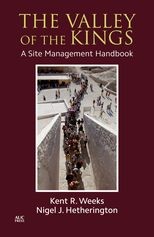The Valley of the Kings: A Site Management Handbook
The Valley of the Kings: A Site Management Handbook
tourism and heritage management specialist; owner and founder
Cite
Abstract
During the New Kingdom (c. 1570–1070 bce), the Valley of the Kings was the burial place of Egypt's pharaohs, including such powerful and famous rulers as Amenhotep III, Rameses II, and Tutankhamen. They were buried here in large and beautifully decorated tombs that have become among the country's most visited archaeological sites. The tourists contribute millions of badly needed dollars to Egypt's economy. But because of inadequate planning, these same visitors are destroying the very tombs they come to see. Crowding, pollution, changes in the tombs’ air quality, ever-growing tourist infrastructure—all pose serious threats to the Valley's survival. This volume, the result of twenty-five years of work by the Theban Mapping Project at the American University in Cairo, traces the history of the Valley of the Kings and offers specific proposals to manage the site and protect its fragile contents. At the same time, it recognizes the need to provide a positive experience for the thousands of visitors who flock here daily. This is the first major management plan developed for any Egyptian archaeological site, and as its proposals are implemented, they offer a replicable model for archaeologists, conservators, and site managers throughout Egypt and the region. Published in both English and Arabic editions and supported by the World Monuments Fund, this critical study will help to ensure the survival of Egypt's patrimony in a manner compatible with the country's heavy reliance on tourism income.
-
Front Matter
-
1
Introduction to the Site
Kent Weeks andNigel Hetherington
-
2
Current Risk Factors
Kent Weeks andNigel Hetherington
-
3
Tourism and the Valley of the Kings
Kent Weeks andNigel Hetherington
-
4
Stakeholder Surveys
Kent Weeks andNigel Hetherington
-
5
Valley of the Kings Condition Survey
Kent Weeks andNigel Hetherington
-
6
Valley of the Kings Infrastructure
Kent Weeks andNigel Hetherington
-
7
Visitor Management in the Valley of the Kings
Kent Weeks andNigel Hetherington
-
8
Site Management at the Valley of the Kings
Kent Weeks andNigel Hetherington
-
End Matter
Sign in
Personal account
- Sign in with email/username & password
- Get email alerts
- Save searches
- Purchase content
- Activate your purchase/trial code
Institutional access
-
Sign in through your institution
- Sign in with a library card Sign in with username/password Recommend to your librarian
Institutional account management
Sign in as administratorPurchase
Our books are available by subscription or purchase to libraries and institutions.
Purchasing information| Month: | Total Views: |
|---|---|
| November 2022 | 1 |
| February 2023 | 2 |
| February 2023 | 3 |
| March 2023 | 4 |
| March 2023 | 1 |
| April 2023 | 1 |
| April 2023 | 2 |
| May 2023 | 2 |
| May 2023 | 2 |
| May 2023 | 2 |
| July 2023 | 3 |
| July 2023 | 2 |
| July 2023 | 4 |
| July 2023 | 1 |
| July 2023 | 1 |
| July 2023 | 5 |
| September 2023 | 4 |
| September 2023 | 3 |
| September 2023 | 1 |
| September 2023 | 3 |
| September 2023 | 2 |
| November 2023 | 2 |
| November 2023 | 3 |
| March 2024 | 2 |
| March 2024 | 1 |
| March 2024 | 1 |
| March 2024 | 2 |



Get help with access
Institutional access
Access to content on Oxford Academic is often provided through institutional subscriptions and purchases. If you are a member of an institution with an active account, you may be able to access content in one of the following ways:
IP based access
Typically, access is provided across an institutional network to a range of IP addresses. This authentication occurs automatically, and it is not possible to sign out of an IP authenticated account.
Sign in through your institution
Choose this option to get remote access when outside your institution. Shibboleth/Open Athens technology is used to provide single sign-on between your institution’s website and Oxford Academic.
If your institution is not listed or you cannot sign in to your institution’s website, please contact your librarian or administrator.
Sign in with a library card
Enter your library card number to sign in. If you cannot sign in, please contact your librarian.
Society Members
Society member access to a journal is achieved in one of the following ways:
Sign in through society site
Many societies offer single sign-on between the society website and Oxford Academic. If you see ‘Sign in through society site’ in the sign in pane within a journal:
If you do not have a society account or have forgotten your username or password, please contact your society.
Sign in using a personal account
Some societies use Oxford Academic personal accounts to provide access to their members. See below.
Personal account
A personal account can be used to get email alerts, save searches, purchase content, and activate subscriptions.
Some societies use Oxford Academic personal accounts to provide access to their members.
Viewing your signed in accounts
Click the account icon in the top right to:
Signed in but can't access content
Oxford Academic is home to a wide variety of products. The institutional subscription may not cover the content that you are trying to access. If you believe you should have access to that content, please contact your librarian.
Institutional account management
For librarians and administrators, your personal account also provides access to institutional account management. Here you will find options to view and activate subscriptions, manage institutional settings and access options, access usage statistics, and more.